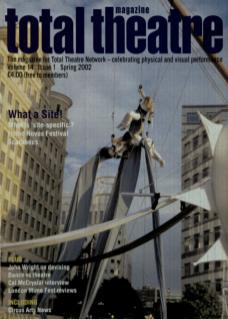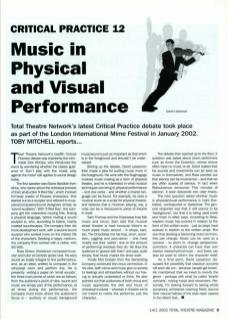Total Theatre Network's twelfth Critical Practice debate was chaired by the inimitable Dick McCaw, who introduced the event by wondering whether the classic guidance of 'Don't play with the mood, play against the mood' still applies to sound design today.
The first speaker was Elaine Bastible from Ishka, who spoke about the rehearsal process of their production A Red Day, which involved full-body masks of Picasso characters. She started out as a sculptor and referred to musicians/composers/sound designers simply as 'sound sculptors'. With A Red Day, the company got the characters moving first, finding a physical language, before inviting a sound sculptor in, who, according to Elaine, mainly created soundscapes. The company then did more development work, with a second sound sculptor who worked more on the interior life of the characters. Seeking a happy medium, the company then worked with a cellist, who did both.
Ross Brown (freelance composer/musician and tutor at Central) spoke next. He sees sound as totally integral to the performance, and, as an ideal, prefers to compose in the rehearsal room and perform live. He is presently writing a paper on 'small sounds', the three main points of which are as follows: from the audience's point of view, sound and music are simply part of the performance; at all times during the performance, the company must know where the audience's focus is – auditory or visual; background music/sound is just as important as that which is in the foreground and shouldn't be undervalued.
Stirring up the debate, David Lasserson then made a plea for putting music more in the foreground. His work with the Gogmagogs involves music-making as a form of physical theatre, and he is interested in what musical techniques can bring to physical performance – and vice versa – and whether a shared language can be found. For example, he sees a musical score as a script for physical theatre, and believes that a musician playing, say, a viola can be a microcosmic piece of theatre in itself.
Sam Thomas and the Chipolatas fuse folk music and circus. Sam said that musical street theatre is hard because there's so much piped music around – in shops, cars, etc. The Chipolatas mix hip-hop, drum, accordion, juggling and percussion – and have mostly lost their ‘patter', due to the amount of performing overseas they do. He likes the audience to 'groove with them' and says, quite simply, that music makes the show work.
Finally, Mat Costain from the Generating Company continued the circus connection. In his view, both circus and music give us access to feelings and atmosphere without our having to actually understand or think. He also pointed out that audiences of both circus and music appreciate the skill and hours of rehearsal involved – whereas in theatre we're not meant to notice the performer, just the character.
The debate then opened up to the floor. A question was asked about clown performers such as Avner the Eccentric, whose shows often have no music at all. David replied that his sounds and movements can be seen as music in themselves, and Ross pointed out that silence can be musical too – and that we are often scared of silence. In fact when Ridiculusmus announce 'Five minutes of silence', it soon descends into utter chaos.
The next question asked whether music in physical/visual performance is more illustrative, contrapuntal or dialectical. The general response was that it still seems to be ‘background', but that it is being used more and more in other ways. According to Ross, western music has evolved in relation to the form of the written score – just as plays have evolved in relation to the written script. But now that devising is becoming more common, this can change. Music can be used as a camera – to zoom in, change perspective, comment. A character can have their own interior metre/rhythm/music – and these can also be used to inform the character itself.
As a final point, David Lasserson discussed the possibility that classical concerts will soon die out because ‘people get bored'. He maintained that we need to revivify the genre – perhaps with what he called 'kinetic concerts', mixing music and movement. Personally, I'm looking forward to seeing whole symphony Orchestras roaming freely around their natural habitat of the wide open spaces in the Albert Hall...

